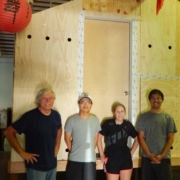Smoke Distributions in a Test Kitchen
ARC has built and used two Test Kitchens and now, has by far the best one, built by Andy McClean and the three summer interns. We are looking at the distribution of smoke and the effect of opening doors and windows. Past tests with the early test kitchens showed that smoke stratified by height with the highest concentrations near the ceiling. Makes sense to cook near the floor! Opening the door dramatically lowered both PM and CO. (See: Test Results of Cook Stove Performance, page 68)

The new Test Kitchen is a bit of an improvement. It has a volume of 30 cubic meters and the air exchange rate is controlled by 48 electric fans that are evenly spaced around the top perimeter of the building. Openings (48) along the bottom perimeter let dilution air in the test kitchen.
For the first experiment in the test kitchen the air exchange rate was determined using the tracer gas decay method (CO from a charcoal stove). The speed of the fans was adjusted until 15 ACH was measured. The smoke distribution while conducting water boiling tests was measured using 30 light scattering based PM detectors (HAPEx) that were hung from the ceiling and evenly spaced throughout the volume. The emissions rate of the rocket stove was measured using an ARC PEMS that was fitted with a partial capture probe and a gravimetric system for measuring PM2.5 (new development!). The gravimetric measurement of PM2.5 was used to calibrate the HAPEx. The tester fed the fire from an opening in the side of the test kitchen so as not to be exposed to the smoke from the fire. The test kitchen was built inside a large barn that had a fan-controlled cross ventilation. The background smoke concentration was recorded during the tests.
Results from the preliminary analysis show that there was vertical stratification, that the smoke in the room was evenly mixed from side to side, and that the average room concentration was similar to that predicted by a single zone box model. Stay tuned for more results!




Leave a Reply
Want to join the discussion?Feel free to contribute!